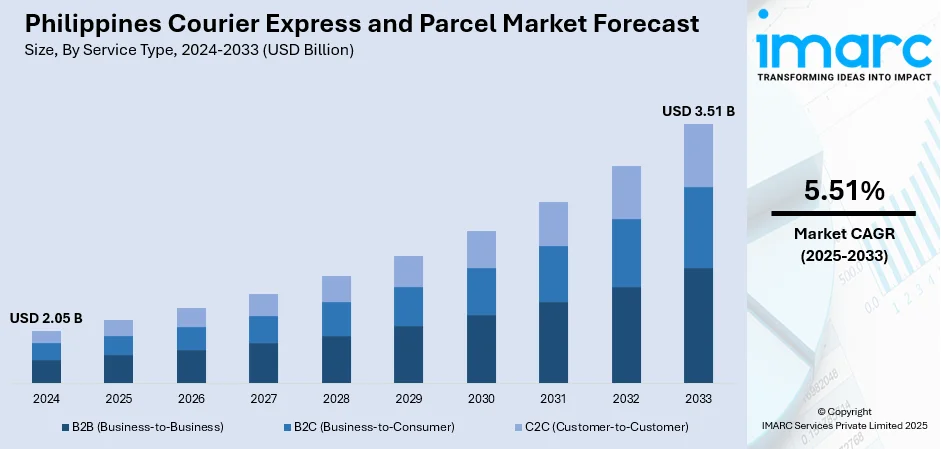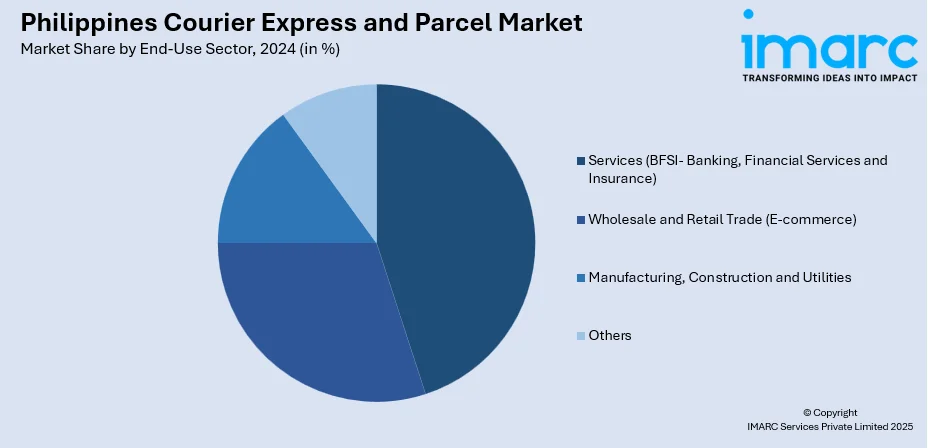
Philippines Courier Express and Parcel Market Size, Share, Trends and Forecast by Service Type, Destination, Type, End-Use Sector, and Region, 2025-2033
Philippines Courier Express and Parcel Market Overview:
The Philippines courier express and parcel market size reached USD 2.05 Billion in 2024. The market is projected to reach USD 3.51 Billion by 2033, exhibiting a growth rate (CAGR) of 5.51% during 2025-2033. Rising e-commerce penetration, growth in cross-border trade, urbanization, and consumer demand for fast delivery are some of the factors contributing to the Philippines courier express and parcel market share. Expanding digital platforms, mobile shopping, logistics infrastructure upgrades, and increasing preference for same-day and next-day deliveries also fuel industry expansion.
|
Report Attribute
|
Key Statistics
|
|---|---|
|
Base Year
|
2024
|
|
Forecast Years
|
2025-2033
|
|
Historical Years
|
2019-2024
|
| Market Size in 2024 | USD 2.05 Billion |
| Market Forecast in 2033 | USD 3.51 Billion |
| Market Growth Rate 2025-2033 | 5.51% |
Philippines Courier Express and Parcel Market Trends:
E-commerce Boom Driving Volume Growth
The surge in online shopping is reshaping the courier, express, and parcel industry in the Philippines. With platforms like Lazada, Shopee, and TikTok Shop becoming household names, parcel volumes have multiplied rapidly. Consumers now expect same-day or next-day delivery, which has forced logistics companies to expand networks beyond Metro Manila into provincial hubs. Small and medium enterprises that previously depended on traditional shipping channels are increasingly turning to app-based couriers, which offer affordable rates and tracking features. This shift has also created demand for micro-fulfillment centers and urban warehouses to shorten delivery times. The pandemic accelerated this transition, but what’s notable today is the sustained appetite for convenience. Even groceries and pharmaceuticals are being delivered by courier networks that were once focused primarily on retail products. The competitive landscape has intensified, with global players like DHL and FedEx competing alongside local operators such as LBC and J&T Express. As digital payments grow, cash-on-delivery is slowly declining, further streamlining the logistics chain. This trend highlights volume-driven growth tied directly to e-commerce expansion. These factors are intensifying the Philippines courier express and parcel market growth.

To get more information on this market, Request Sample
Sustainability and Green Logistics Taking Hold
Another distinct trend shaping the Philippine CEP market is the gradual but growing emphasis on sustainability. Consumers are becoming more environmentally conscious, pushing couriers to rethink packaging, delivery methods, and overall operations. Large players are experimenting with electric motorcycles and bicycles for last-mile delivery, especially in congested areas like Metro Manila and Cebu. Packaging innovations, such as biodegradable pouches and reusable boxes, are beginning to appear, often marketed as premium options to eco-minded shoppers. Although cost remains a barrier, pilot programs suggest long-term savings in fuel and operational efficiency. International courier firms, influenced by global sustainability commitments, are bringing these practices into the Philippines, setting benchmarks for local competitors. The government has also started nudging the industry by promoting cleaner transport alternatives and congestion reduction policies. The focus on green logistics is not yet mainstream, but it is gaining momentum, particularly among younger consumers who prioritize eco-friendly brands. Over time, sustainability is expected to evolve from a marketing differentiator into an operational necessity, changing the way couriers approach delivery in the country.
Philippines Courier Express and Parcel Market Segmentation:
IMARC Group provides an analysis of the key trends in each segment of the market, along with forecasts at the country and regional level for 2025-2033. Our report has categorized the market based on service type, destination, type, and end-use sector.
Service Type Insights:
- B2B (Business-to-Business)
- B2C (Business-to-Consumer)
- C2C (Customer-to-Customer)
The report has provided a detailed breakup and analysis of the market based on the service type. This includes B2B (business-to-business), B2C (business-to-consumer), and C2C (customer-to-customer).
Destination Insights:
- Domestic
- International
The report has provided a detailed breakup and analysis of the market based on the destination. This includes domestic and international.
Type Insights:
- Air
- Ship
- Subway
- Road
The report has provided a detailed breakup and analysis of the market based on the type. This includes air, ship, subway, and road.
End-Use Sector Insights:

- Services (BFSI- Banking, Financial Services and Insurance)
- Wholesale and Retail Trade (E-commerce)
- Manufacturing, Construction and Utilities
- Others
The report has provided a detailed breakup and analysis of the market based on the end-use sector. This includes services (BFSI- banking, financial services and insurance), wholesale and retail trade (e-commerce), manufacturing, construction and utilities, and others.
Regional Insights:
- Luzon
- Visayas
- Mindanao
The report has also provided a comprehensive analysis of all the major regional markets, which include Luzon, Visayas, and Mindanao.
Competitive Landscape:
The market research report has also provided a comprehensive analysis of the competitive landscape. Competitive analysis such as market structure, key player positioning, top winning strategies, competitive dashboard, and company evaluation quadrant has been covered in the report. Also, detailed profiles of all major companies have been provided.
Philippines Courier Express and Parcel Market News:
- May 2025: FedEx introduced its monitoring and intervention service, FedEx Surround, in the Philippines to boost the courier express and parcel market. The tool provides near real-time analytics, giving businesses better control and visibility over deliveries. FedEx Philippines managing director said the service aims to strengthen local businesses’ logistics and supply chain capabilities, addressing growing complexity in the country’s delivery sector.
Philippines Courier Express and Parcel Market Report Coverage:
| Report Features | Details |
|---|---|
| Base Year of the Analysis | 2024 |
| Historical Period | 2019-2024 |
| Forecast Period | 2025-2033 |
| Units | Billion USD |
| Scope of the Report |
Exploration of Historical Trends and Market Outlook, Industry Catalysts and Challenges, Segment-Wise Historical and Future Market Assessment:
|
| Service Types Covered | B2B (Business-to-Business), B2C (Business-to-Consumer), C2C (Customer-to-Customer) |
| Destinations Covered | Domestic, International |
| Types Covered | Air, Ship, Subway, Road |
| End-Use Sectors Covered | Services (BFSI- Banking, Financial Services and Insurance), Wholesale and Retail Trade (E-commerce), Manufacturing, Construction and Utilities, Others |
| Regions Covered | Luzon, Visayas, Mindanao |
| Customization Scope | 10% Free Customization |
| Post-Sale Analyst Support | 10-12 Weeks |
| Delivery Format | PDF and Excel through Email (We can also provide the editable version of the report in PPT/Word format on special request) |
Key Questions Answered in This Report:
- How has the Philippines courier express and parcel market performed so far and how will it perform in the coming years?
- What is the breakup of the Philippines courier express and parcel market on the basis of service type?
- What is the breakup of the Philippines courier express and parcel market on the basis of destination?
- What is the breakup of the Philippines courier express and parcel market on the basis of type?
- What is the breakup of the Philippines courier express and parcel market on the basis of end-use sector?
- What is the breakup of the Philippines courier express and parcel market on the basis of region?
- What are the various stages in the value chain of the Philippines courier express and parcel market?
- What are the key driving factors and challenges in the Philippines courier express and parcel market?
- What is the structure of the Philippines courier express and parcel market and who are the key players?
- What is the degree of competition in the Philippines courier express and parcel market?
Key Benefits for Stakeholders:
- IMARC’s industry report offers a comprehensive quantitative analysis of various market segments, historical and current market trends, market forecasts, and dynamics of the Philippines courier express and parcel market from 2019-2033.
- The research report provides the latest information on the market drivers, challenges, and opportunities in the Philippines courier express and parcel market.
- Porter's Five Forces analysis assists stakeholders in assessing the impact of new entrants, competitive rivalry, supplier power, buyer power, and the threat of substitution. It helps stakeholders to analyze the level of competition within the Philippines courier express and parcel industry and its attractiveness.
- Competitive landscape allows stakeholders to understand their competitive environment and provides an insight into the current positions of key players in the market.
Need more help?
- Speak to our experienced analysts for insights on the current market scenarios.
- Include additional segments and countries to customize the report as per your requirement.
- Gain an unparalleled competitive advantage in your domain by understanding how to utilize the report and positively impacting your operations and revenue.
- For further assistance, please connect with our analysts.
 Request Customization
Request Customization
 Speak to an Analyst
Speak to an Analyst
 Request Brochure
Request Brochure
 Inquire Before Buying
Inquire Before Buying




.webp)




.webp)












